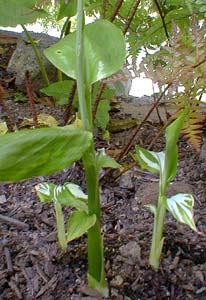
Hardy Japanese Ginger; aka,
'Dancing Crane' Myoga; aka,
Variegated Mioga Ginger; aka,
Japanese Woodland Ginger
This June photo shows the first shoots of Variegated Japanese Ginger (Zingiber mioga 'Dancing Crane') popping up in the shade garden. It is reputedly a little hardier in the garden than is the species, which can be tender. Once it gets established it is a tough plant, but is for the first year susceptible to rot from poor drainage especially during winter dormancy, & prone to sunburn or becoming chloratic if insufficiently shaded.
'Dancing Crane' is both variegated & dwarfed. At about 18" height, it looks like a miniature stand of bamboo, but unlike bamboo it blooms, having aromatic yellow flowers. The spring shoots & early autumn flower buds are edible. The buds develop underground & by the time they emerge they are too mature for harvest, so have to be picked before they are visible. When grown specifically for harvest, a shallow layer of sawdust is laid around the stalks so that buds may be found by pushing the sawdust aside, picked every two or three days for up to two autumn months.
I have not yet had the opportunity to eat any from our garden, & will not attempt any harvest until it gets established as a big clump foremost of ornamental value. If it is ever a large enough clump that it can bear some bits taken out of it & still look nice, then I will consider digging around for autumn buds or spring shoots.
In the Chinese pharmacopia it is used to treat fever & as a vermifuge. The species is a native of temperate mountains of western China, ranging into Japan though probably as a long-ago introduced food plant that naturalized on wooded mountainsides. The smaller, variegated form was developed in Japan by Dr. Masato Yokoi, co-author of Variegated Plants in Color. Dr. Yokoi is sometimes called "Mister Variegated" because he has developed so many variegated plants.
'Dancing Crane' has lightning-shaped pure white patterning on deep green leaves. This foliage vanishes in winter, & its rhyzomes may need protective mulching if winters get too cold. I don't bother to mulch our gardens, as winters on Puget Sound are rather mild, but I do let leaf-fall remain on the shade gardens as a natural mulch that breaks down into leafmold.
Mioga may go dormant in the hottest days of summer unless persistently moist & protected from too much sun. It should do well in zones seven through ten, & is ideal for zone 8, impervious to disease so long as the ground drains well giving it no reason to rot in winter.